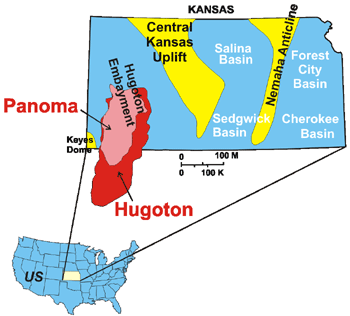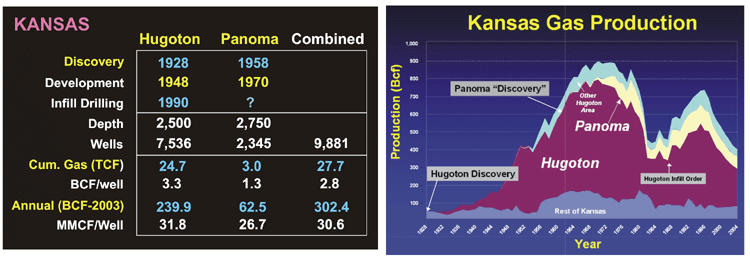Accommodation Model for Wolfcamp (Permian) Redbeds at the Updip Margin of North America's Largest Onshore Gas Field
Martin K. Dubois, Kansas Geological Survey and Robert H. Goldstein, University of Kansas
Purpose
To determine the accommodation and stabilization mechanisms that led to a lateral transition between Permian marine-carbonate-dominated sequences and continental-siliciclastic-dominated sequences at the margin of a giant gas field.
In the Kansas portion of the Hugoton Embayment of the Anadarko Basin, Council Grove Group red silts and very fine-grained sands of probable continental origin are up to four times thicker updip than they are in the middle to outer portion of the gently dipping ramp. Interbedded with the siliciclastics are shoaling-upward marine carbonates, the principal gas reservoirs in the fields, that were deposited during times of high sea level on the low-relief shelf. Carbonate units thin to the northwest where the red siliciclastics are thickest. A few of the carbonate units pinch out where the siliciclastics thicken in a position nearly coincident with the field margin. The redbeds have been suggested to be the lateral seal for the field and understanding the mechanisms for depositing the siliciclastics high on the shelf is critical to understanding reservoir geometry of the largest onshore gas deposit in North America.
Major Points
- Much continental siliciclastic accumulation in the Council Grove results from biostabilization (plant and animal-induced) rather than by accommodation related to sea-level rise
- Continental siliciclastics of eolian origin built relief that reduced accommodation for marine carbonates at the updip field margins
- Continental siliciclastics are not a lateral seal for the Panoma Field even though the field margin is coincident with pinchout of marine carbonates
- There is a predictable succession of continental lithofacies controlled by the interaction of climate, glaciation/de-glaciation, and sea level
Approach
Mechanisms considered for deposition of siliciclastics
|
 |
Field History
The 70-year old Hugoton and Panoma Field has yielded 34 TCF gas from the Wolfcampian Chase and Council Grove Groups. In the center of the field the combined gross pay is up to 130 meters thick (430 feet) and production is from thirteen fourth-order marine-continental sedimentary sequences. The two fields, Hugoton (Chase) and the underlying Panoma (Council Grove), have been regulated separately, but the two are more likely a common reservoir.

http://www.kgs.ku.edu/PRS/AAPG2005/2005-25/p1-01.html
Last Modified November 2005